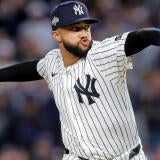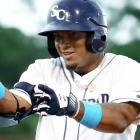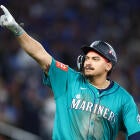Top 10 MLB prospects 2020: Shortstop led by Wander Franco, but Carter Kieboom ready for Fantasy impact
Shortstop is a position of studs these days, and with the caliber of prospects manning it in the minors, that doesn't figure to change anytime soon.
Shortstop has never been lacking for talent in the minors. The kind of players who play in the minors were all the best on their high school teams, and in high school the best players play shortstop.
A more recent development, though, is those players actually sticking at shortstop. Maybe teams have just gotten better at separating the most able from the lost causes further down the minor-league ladder, or maybe they've gotten better at coaching up the borderline cases. They have every incentive to keep the big bats at the premium positions, after all.
They've gotten so good at it in recent years, though, that shortstop is now one of the more crowded positions in the majors, and thus, some of the top shortstop prospects today are going to have change positions just by necessity. Naturally, some are clearer candidates for a position change than others, and those cases are noted.
It would help if they'd go ahead and do it just to balance out my Top 10s a little more. Some painful omissions from this overloaded list include potentially high-impact teenagers like Marco Luciano of the Giants and Ronny Mauricio of the Mets. Look out for them on next year's list. Former Yankees prospect Jorge Mateo, now with the Athletics, has lost much of his shine but is nonetheless on the verge of breaking through with some speed and moderate power. Tyler Freeman of the Indians and Brice Turang of the Brewers profile as quality table setters with fairly safe profiles, and the Phillies' Bryson Stott, drafted 14th overall this past year, is deserving of love as well.
But they just couldn't fit on a list that goes only 10 deep, led of course by the top prospect in all of baseball.
Note: This list is intended for a variety of Fantasy formats and thus weighs short-term role against long-term value. Not all of these players will contribute in 2020 — most, in fact, will not — but among prospects, they're the names Fantasy owners most need to know.
1. Wander Franco, Rays
Age (on opening day): 19
Where he played in 2019: low Class A, high Class A
Minor-league stats: .327 BA (425 AB), 9 HR, 27 2B, 18 SB, .885 OPS, 56 BB, 35 K
Franco's preternatural hitting ability was widely recognized at as young as 17 and was on full display in his first season of full-season ball. He led the Florida State League (the higher of the two levels he played) in hitting despite being a year younger than any other player there. But even beyond the stats, it's his attributes -- from his strike-zone awareness to his pitch recognition to his plate coverage -- that suggest he's a star in the making, possibly getting his first taste of the majors this upcoming season.
2. Carter Kieboom, Nationals
Age (on opening day): 22
Where he played in 2019: Triple-A, majors
Minor-league stats: .303 BA (412 AB), 16 HR, 24 2B, .902 OPS, 68 BB, 100 K
Major-league stats: .128 BA (39 AB), 2 HR, .491 OPS, 4 BB, 16 K
Pressed into major-league duty because of an early-season injury to Trea Turner, Kieboom was a disaster both offensively and defensively, but he seemed to take it all in stride, returning to put up stud numbers at Triple-A. He has a mature approach and recognizes breaking balls well, giving him a low-risk profile even as he continues to develop as a power hitter. Defensively, he profiles better at second base, where the Nationals have added Starlin Castro and re-signed utility options Asdrubal Cabrera and Howie Kendrick.
3. Royce Lewis, Twins
Age (on opening day): 20
Where he played in 2019: high Class A, Double-A
Minor-league stats: .236 BA (517 AB), 12 HR, 22 SB, .661 OPS, 38 BB, 123 K
An MVP performance in the Arizona Fall League, where he hit .353 with three homers and a .975 OPS in 22 games, redeemed what was an otherwise discouraging season for the former No. 1 overall pick, who struggled even in a return trip to high Class A to begin the year. Most evaluators are inclined to give the benefit of the doubt to a player who had performed up to his pedigree prior to 2019 and whose complicated mechanics most likely contributed to his struggles. It's what the minors are for.
4. C.J. Abrams, Padres
Age (on opening day): 19
Where he played in 2019: Rookie, low Class A
Minor-league stats: .393 BA (150 AB), 3 HR, 15 SB, 1.083 OPS, 11 BB, 14 K
Athleticism was the most cited reason for the Padres making Abrams the sixth overall pick in 2019, and it's true he can motor. But his bat skills were the ultimate takeaway from his first professional season, which saw him slash line drives to all fields while routinely taking the extra base. Power isn't supposed to be a big part of his skill set, but when a player so young shows such aptitude, it's hard to say exactly what the limits of his upside are, especially in a power-friendly era.
5. Bobby Witt, Royals
Age (on opening day): 19
Where he played in 2019: Rookie
Minor-league stats: .262 BA (164 AB), 1 HR, 9 SB, .670 OPS, 13 BB, 35 K
The second player off the board in 2019 gets all benefit of the doubt for now, especially since he wouldn't be the first high school sensation to sputter in his introduction to pro ball. He still earns high marks across the board, perhaps having some vulnerability to the strikeout but with a strong enough hit tool to overcome it. A Trevor Story-like outcome is plausible.
6. Nico Hoerner, Cubs
Age (on opening day): 22
Where he played in 2019: Rookie, Double-A, majors
Minor-league stats: .292 BA (288 AB), 3 HR, 17 2B, 8 SB, .752 OPS, 22 BB, 32 K
Major-league stats: .282 BA (78 AB), 3 HR, 1 3B, 1 2B, .741 OPS, 3 BB, 11 K
The plan almost certainly wasn't for Hoerner to join the big club only a year after getting drafted, promoting him straight from Double-A. But when a shortage up the middle forced the Cubs to dig deep during the September stretch run, he more than answered the call, electrifying the fan base with a bevy of big hits that proved his exceptional bat-to-ball skills are ready for prime time, perhaps as team's second baseman this year. Evaluators are divided on whether he'll develop enough power to be a true standout.
7. Jordan Groshans, Blue Jays
Age (on opening day): 20
Where he played in 2019: low Class A
Minor-league stats: .337 BA (83 AB), 2 HR, 6 2B, .909 OPS, 13 BB, 21 K
The 12th overall pick in 2018 still has a great deal of mystery surrounding him after his first year of full-season ball was hijacked by a foot injury, but the month he did play was impressive enough get evaluators thinking in terms of best-case scenario, which would be something akin to David Wright. He has an advanced approach, a knack for barreling up balls and a proclivity for driving them the other way. And yes, he's likely to wind up at third base.
8. Oneil Cruz, Pirates
Age (on opening day): 21
Where he played in 2019: Rookie, high Class A, Double-A
Minor-league stats: .298 (265 AB), 8 HR, 11 SB, .832 OPS, 24 BB, 74 K
Cruz stands out mainly for two things: his size and his ceiling. A wiry 6-feet-6, it stands to reason he'll no longer be mobile enough to man shortstop once he fills out, but in filling out, he also has a chance of unlocking enormous power potential -- the sort that could make him a 40-homer man down the road. It's a surprisingly wide range of outcomes for a prospect who has already advanced to Double-A, but you invest in him hoping the big breakthrough is still yet to come.
9. Jazz Chisholm, Marlins
Age (on opening day): 22
Where he played in 2019: Double-A
Minor-league stats: .220 (395 AB), 21 HR, 16 SB, .761 OPS, 52 BB, 147 K
The Marlins took a leap of faith on Chisholm at the trade deadline last year, dealing away what looked like a clear victory for their farm system in Zac Gallen for a relative lottery ticket. Chisholm has some exciting tools, namely power along with some speed, and showed improvement in his first month in the Marlins organization, batting .284 with three homers, three steals and a manageable 25.5 percent strikeout rate. But it's those swing-and-miss tendencies that make it less likely that he reaches his full potential.
10. Jeter Downs, Dodgers
Age (on opening day): 21
Where he played in 2019: high Class A, Double-A
Minor-league stats: .276 (460 AB), 24 HR, 35 2B, 24 SB, .888 OPS, 60 BB, 107 K
Whatever tools Downs was beginning to show in his two years in the Reds organization the Dodgers saw fit to sharpen in his first year with them. It's what they do, right? He already looked like a pretty good base-stealer with an above-average hit tool, and while the power breakthrough bears closer scrutiny given that he spent most of the year in the hitter-friendly California League, he did homer five times in just 12 games after moving up to Double-A.























